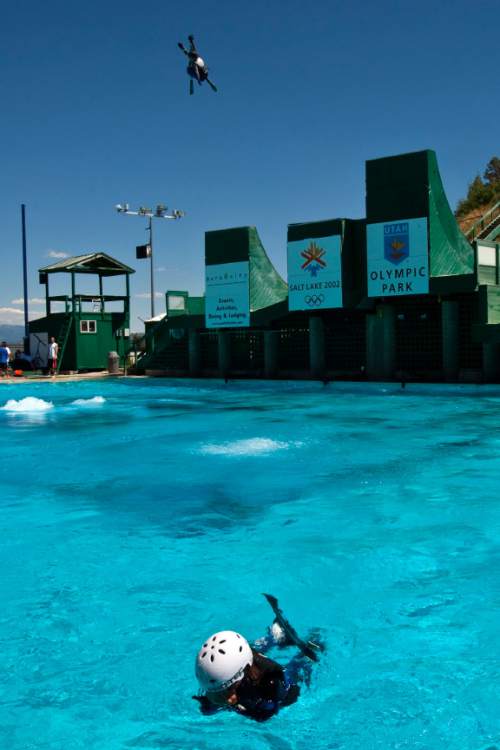This is an archived article that was published on sltrib.com in 2014, and information in the article may be outdated. It is provided only for personal research purposes and may not be reprinted.
Utah's long-term commitment to provide top-flight training facilities for the country's winter-sports athletes is continuing with a $3 million modernization project underway at Utah Olympic Park outside of Park City.
The park's aerials training facility — four wooden ramps that skiers use to go airborne before descending into an 700,000-gallon swimming pool — is being revitalized over the winter after 22 years of consistent use.
When the facility reopens next June, there will be eight ramps instead of four. And the pool will be expanded to more than 1-million gallons.
"We're at a capacity problem now," said Colin Hilton, president and CEO of the Utah Olympic Legacy Foundation, which has operated the park and the Utah Olympic Oval in Kearns since the end of the 2002 Winter Olympics.
"Every day, all though the summer from 8 a.m. to 7 p.m., the facility is being used by various groups, everyone from beginners to development athletes to the elite U.S. National teams," he added.
But the expansion is not just a matter of increasing capacity. The new array of ramps will have differing lengths and launching angles that will provide better training for the growing number of winter-sports disciplines now on the Olympic agenda.
One ramp will serve moguls skiers. Another will be designed to fit the needs of slopestyle competitors, both skiers and snowboarders. Hilton noted that neither of those disciplines need the high-flying lift provided by the original ramps, as freestyle aerialists do, but they do need longer landing zones.
"This renovation will help all of them train for more medals," he said, adding that U.S. athletes who trained regularly on the park's facilities already have won more than a dozen Olympic and World Championship medals.
Few people recognize the importance of these training facilities better than Luke Bodensteiner, executive vice president of athletics for the Park City-based U.S. Ski and Snowboard Association (USSA).
"This is a great project for us to collaborate on," he said. "Something like this doesn't exist anywhere in the world. Through this redesign, we'll be able to expand our training capacity in a substantial way."
While Bodensteiner's attention focuses primarily on elite athletes, he fully supports the Utah Olympic Legacy Foundation's desire to open the facility to youth groups and community members.
Besides being the right thing to do, he said, it exposes kids to winter sports and builds a foundation for the future.
"We always conceptualize about what we have to do to win today," Bodensteiner said, "but simultaneously we have to prepare for tomorrow. How do we build our teams for 2022 and 2026 [future Winter Games years] along with the project immediately in front of us" — the 2018 Winter Olympics in Pyeongchang, South Korea.
Hilton said the work is being done this winter to minimize the impact on elite U.S. athletes training for 2018. The general contractor, Jacobsen Construction, will shave back the hill beneath the ramps to create conditions that more closely "simulate competitions on snow" and will oversee the development of modular steel ramps in a Salt Lake City warehouse.
Going with modular steel will reduce long-term maintenance — "water beats up the wooden stairs pretty good through the summer," he noted — and also provides greater flexibility. "As the sports continue to change, we can more easily adapt our [launch] trajectories."
This is the second of several sizable renovations being done to keep the facilities highly functional and financially stable. The first involved the installation of solar panels in the Olympic Oval parking lot. That will generate much of the electricity needed to operate that energy-intensive facility.
"Maintaining our facilities at world-class levels is a strategic part of our mission to provide the best training environment for winter-sport athletes," Hilton said.
The ability to deliver that kind of experience was one of Salt Lake City's strongest selling points in the late 1980s when the effort to attract the Winter Olympics got serious. Voters approved a sales-tax diversion to build training facilities before there was any guarantee the city would be selected to stage the Games.
"We're reaping the benefits of that forward thinking," Bodensteiner said.
Twitter: @sltribmikeg —
Financially stable
The Utah Olympic Legacy Foundation inherited a $76 million endowment from the Salt Lake Organizing Committee to run the Olympic Park and the Olympic Oval after the 2002 Games. Foundation Executive Director Colin Hilton said $67 million remains in the endowment, which at one time grew to $80 million before the Great Recession helped knock it back to $52 million. Better stock market conditions and double-digit revenue increases in each of the last five years from public activities at the park helped restore some of the lost funding, he added.





